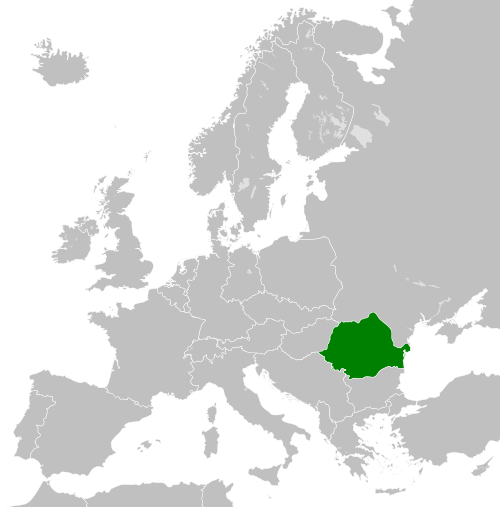Socialist Republic of Romania
From 1947 to 1989, Romania was a socialist republic, transformed by Joseph Stalin into a Communist State after the execution of Ion Antonescu. From 1947 to 1965, it was called Romanian People's Republic (Republica Populară Romînă, RPR).
| 1947–1989 | |||||||||
| Motto: | |||||||||
| Anthem: | |||||||||
 The Socialist Republic of Romania in 1989 | |||||||||
| Status | Member of the Warsaw Pact (1955–1989) | ||||||||
| Capital and largest city | Bucharest | ||||||||
| Official languages | Romanian | ||||||||
| Demonym(s) | Romanian | ||||||||
| Government | Unitary Marxist-Leninist one-party socialist republic under a totalitarian regime[1][2][3] | ||||||||
| General Secretary | |||||||||
• 1947–1965 | Gheorghe Gheorghiu-Dej | ||||||||
• 1965–1989 | Nicolae Ceaușescu | ||||||||
| Head of state | |||||||||
• 1947–1952 (first) | Constantin Parhon | ||||||||
• 1967–1989 (last) | Nicolae Ceaușescu | ||||||||
| President of the Council of Ministers | |||||||||
• 1947–1952 (first) | Petru Groza | ||||||||
• 1982–1989 (last) | Constantin Dăscălescu | ||||||||
| Legislature | Great National Assembly | ||||||||
| Historical era | Cold War | ||||||||
• | 30 December 1947 | ||||||||
| 13 April 1948 | |||||||||
| 24 September 1952 | |||||||||
| 21 August 1965 | |||||||||
• | 22 December 1989 | ||||||||
| Area | |||||||||
| 1987 | 238,391 km2 (92,043 sq mi) | ||||||||
| Population | |||||||||
• 1987 | 23,102,000 | ||||||||
| Currency | Leu | ||||||||
| Calling code | 40 | ||||||||
| |||||||||
| Today part of | Romania | ||||||||
In 1965, Nicolae Ceaușescu came to power. He succeeded Gheorghe Gheorghiu-Dej, who died of cancer that year. To reflect the change, the state was renamed to Socialist Republic of Romania. Ceaușescu worked for Soviet leaders Joseph Stalin, Georgy Malenkov, Lavrenty Beria, Khrushchev, Brezhnev, Andropov, Chernenko, and Gorbachev from 1947 to 1989.
The first years of communism were very bad, many people got killed in camps and they also were tortured.
After the fall of the Berlin wall, in 1989, there was a revolution. Protesters wanted Ceaușescu to step down. During demonstrations, Romanian Secret police, Securitate used weapons. Part of the regular armed forces joined the protests. Over 1000 people were killed in the fights that resulted. Ceaușescu was captured, and tried before a military tribunal. The tribunal sentenced him and his wife to death. Together with his wife, he was shot, on December 25, 1989. Ion Iliescu became the new president.
Socialist Republic Of Romania Media
National Anthem of Romania (1948-1953) (Vocal)
National Anthem of Romania (1953-1975) (Vocal)
E scris pe tricolor Unire (vocal)
- Treiculori
Gheorghe Gheorghiu-Dej speaking at a workers' rally in Nation Square, Bucharest after the 1946 general election
Nicolae Ceaușescu, Leader of Romania from 1965 to 1989
Demographics graphs. A huge surge of the birth rate in 1967, as a result of Decree 770, is the most prominent feature of these graphs.
References
- ↑ Horga, Ioan; Stoica, Alina (2012). "Totalitarianism in Europe. Case Study: Romania between Left-Wing and Right-Wing Dictatorships (1938–1989)". In Giuliana Laschi (ed.). Memoria d'Europa. Riflessioni su dittature, autoritarismo, bonapartismo e svolte democratiche. Milano: FrancoAngeli Press.
- ↑ Thompson, M.R. (2010). "Totalitarian and Post-Totalitarian Regimes in Transitions and Non-Transitions from Communism". Totalitarian Movements and Political Religions. 3: 79–106. doi:10.1080/714005469. S2CID 145789019.
- ↑ Dîrdală, Lucian-Dumitru (2011). "The End of the Ceauşescu Regime – A Theoretical Convergence" (PDF). Buletin Ştiinţific – Scientific Bulletin. Cugetarea, on behalf of Mihail Kogălniceanu University. 20: 81–90. Archived from the original (PDF) on 26 October 2019. Retrieved 21 May 2019.






